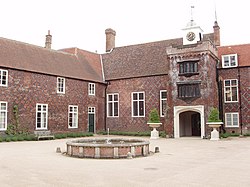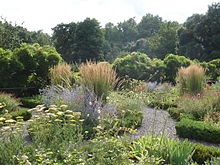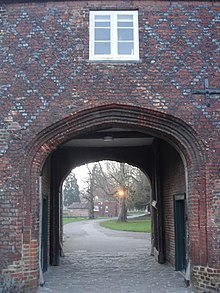Fulham Palace
This article includes a list of general references, but it lacks sufficient corresponding inline citations. (September 2012) |
| Fulham Palace | |
|---|---|
 Fulham Palace courtyard | |
 | |
| General information | |
| Type | Bishop's Palace |
| Architectural style | Medieval, Tudor. |
| Location | Fulham Part of the London Borough of Hammersmith and Fulham |
| Address | Bishop's Avenue, London, SW6, England, UK |
| Town or city | London |
| Country | England |
| Current tenants | Fulham Palace Trust |
| Completed | c. 13th century |
| Owner | Church of England |
| Technical details | |
| Structural system | Brick, Stone. |

Fulham Palace in Fulham, London (formerly in Middlesex), England, at one time the main residence of the Bishop of London, is of medieval origin. It was the country home of the Bishops of London from at least 11th century until 1975, when it was vacated. It is still owned by the Church of England, although managed by the London Borough of Hammersmith and Fulham and the Fulham Palace Trust. It is adjacent to Bishops Park, houses a museum of the palace's history, and has an extensive botanical garden.
History
Origins
During the extensive restorations from 2001–06, excavations on the grounds of Fulham Palace have revealed the remains of several former large scale buildings and even evidence of Neolithic and Roman settlements. Habitation on the land on which the Palace stands can be traced back to as early as c.700 AD, when ownership passed to Waldhere, Bishop of London. The estate was owned by the Bishops of London for over 1300 years and the Palace was their country home from at least the 11th century, and their main residence from the early 20th century until 1973.[citation needed]
17th century
In the early part of the 17th century, the gardens at Fulham Palace appear to have suffered from some unsympathetic attention. The antiquary John Aubrey records among his memoranda, "the Bishop of London did cutte-down a noble Clowd of trees at Fulham", occasioning the sharp remark from Sir Francis Bacon, a dedicated gardener, "that he was a good Expounder of dark places."[1]
Henry Compton was ordained Bishop of London in 1675; he imported several new plant species to the gardens at Fulham Palace and first cultivated some flora found in Britain today, including the American magnolia, M. virginiana, Liriodendron, Liquidambar and the first American azalea grown in England, Rhododendron viscosum.[2] In his heated "stoves" he grew the first coffee tree in England. The red horse chestnut, a hybrid of Aesculus hippocastanum and the American Aesculus pavia, was still noted in Fulham Palace gardens as late as 1751.
By 1681, the gardens at Fulham Palace were already remarkable, as John Evelyn noted when he visited them.[3] Bishop Compton's gardener in the early years was George London, who started his famous nursery at Brompton the year of Evelyn's visit. By 1686 William Penn's gardener was hoping to exchange the exotic flora of Pennsylvania for seedlings and slips of trees and shrubs and seeds from Fulham Palace gardens.[3] His staunch defence of his former pupils the Princesses Mary and Anne, led to his appointment as Deputy Superintendent of the Royal Gardens to William and Mary, and a Commissioner for Trade and Plantations. In the colonies, he had a botanical correspondent in John Bannister, who was sent first to the West Indies and then to Virginia, and who, before his untimely death, sent Bishop Compton drawings, seeds, and herbarium specimens from which the Bishop's close friend John Ray compiled the first published account of North American flora, in his Historia Plantarum (1688). [citation needed]
World War I
Part of the Palace grounds was converted into allotments during World War I in 1918, to grow food to help the war effort. In 1918 the Palace itself was used as a military hospital.[citation needed]
World War II
Parts of the Palace were damaged by bombing, and after the war the Church found it increasingly difficult to maintain this large, expensive historic building. In 1954 the Church Commissioners' architect described the Palace as "badly planned and inconvenient".[4] After many years of indecision the Church finally vacated the Palace in 1975.
Fulham Palace today

This article needs to be updated. (February 2013) |
The grounds of the Palace originally covered more than 30 acres (120,000 m2), though today only 12 acres (49,000 m2) remain. The Palace also boasts the longest moat in England. [citation needed] Although the Palace has its own chapel, the gardens adjoin the churchyard of the neighbouring parish church, All Saints Church, Fulham, where several former bishops are buried. The allotments planted during the war still survive; many are still in use, allowing local people to grow their own vegetables, fruit and flowers. [citation needed]
In spite of the depredations of Henry Compton's successor, some of the ancient trees in and around Fulham Palace remain to this day, and visitors can still see the knot garden and wisteria which survive in the Palace's walled gardens. A large holm oak (quercus ilex)is believed to be 500 years old and has been designated a Great Tree of London. The Palace and gardens are today managed jointly by the London Borough of Hammersmith and Fulham and by the Fulham Palace Trust, though the land and buildings are still owned by the Church of England. [citation needed]
Fulham Palace and grounds have been run by the Fulham Palace Trust since 1 April 2011. Phase Two of the Fulham Palace Restoration Project began in 2010 and is due for completion in October 2011, made possible by a grant from the Heritage Lottery Fund. Phase Two includes both the restoration of the Palace grounds and the nearby Bishops Park. The Park was formerly part of the Palace estate and opened to the public in 1893. The walled garden at Fulham Palace is to be brought back into use as a working kitchen garden and the vineries (originally built by Weeks of Chelsea) are to be rebuilt. [citation needed]
Museum and art gallery




The Museum of Fulham Palace partially occupies Bishop Howley's Dining Room and the Porteus Library (named after Bishop Beilby Porteus, 1731–1809), in the early 19th century part of the Palace. It contains some of the paintings that once hung in the building, stained glass, carved fragments of masonry and the bishop's cope, as well as displays describing the Palace's history. [citation needed]
The lost manuscript of William Bradford's Of Plymouth Plantation (1620–47), an important founding document of the United States, was discovered in the library in 1855 and first published the next year. No one knows how it made its way there from America, but in 1897, through the efforts of US Senator George Frisbie Hoar, it was repatriated to New England. [citation needed]
There is also an art gallery, known as Fulham Palace Gallery, which displays work related to the history of the building and its grounds.
The Palace's art collection includes two 1798 works by Benjamin West, Margaret of Anjou and Thomas a Becket; an oil on canvas of Field Marshal George Wade by Adriaen van Diest; and an oil on canvas of Beilby Porteus by John Hoppner.[5]
There is a Reginald Henry Lewis oil on canvas of William Wand.[5]
Visitor access
Admission to the Palace and its grounds is free of charge. The grounds are open daily from dawn to dusk. A cafe has been opened in Bishop Howley's Drawing Rooms. The Palace can be accessed from Fulham Palace Road, close to the northern end of Putney Bridge.
Future
A second phase of excavation works is planned, but will be subject to the success of a future bid to the Heritage Lottery Fund. [citation needed]
Transport connections
| Service | Station/Stop | Lines/Routes served | Distance from Fulham Palace |
|---|---|---|---|
| London Buses |
Bishops Park Road (Stop FN) |
74, 220, 430 | 550 metres walk[6] |
| Fulham High Street (Stop FJ and FU) |
14, 74, 220, 414, 430 | 650 metres walk[7] | |
| Putney Bridge Fulham High St (Stop FW) |
22, 424 | 550 metres walk[8] | |
| Putney Bridge Stn Gonville St (Stop FE) |
14, 22, 39, 74, 85, 93, 265, 424, 430, |
650 metres walk[9] | |
| London Underground |
Putney Bridge | 700 metres walk[10] | |
| National Rail |
Putney railway station | South West Trains | 1.500 metres walk[11] |
See also
Notes
- ^ Oliver Lawson Dick, ed. Aubrey's Brief Lives. Edited from the Original Manuscripts, 1949, s.v. "Francis Bacon, Viscount of St. Albans", p. 11.
- ^ Hortus Kewensis credits Bishop Compton with some forty introductions, two-thirds of them hardy trees and shrubs (Alice M. Coats, "The Hon. and Rev. Henry Compton, Lord Bishop of London" Garden History 4.3 (Autumn, 1976:14–20) p. 18)
- ^ a b Coats 1976:14.
- ^ Chandler, Andrew, p.140, The Church of England in the Twentieth Century: the Church Commissioners Retrieved January 2012
- ^ a b coordinator; photographers, Rosie MacArthur ;; Johnson, Andy; Piperger, Justin (2013). Oil paintings in public ownership in London, West. London: Public Catalogue Foundation. pp. 87–91. ISBN 9781909475151.
{{cite book}}:|access-date=requires|url=(help)CS1 maint: extra punctuation (link) CS1 maint: multiple names: authors list (link) - ^ "Walking directions to Stop FN" (Map). Google Maps. Retrieved 4 November 2011.
- ^ "Walking directions to Fulham High St/A219" (Map). Google Maps. Retrieved 4 November 2011.
- ^ "Walking directions to Putney Bridge Fulham High St (Stop FW)" (Map). Google Maps. Retrieved 4 November 2011.
- ^ "Walking directions to Fulham, Putney Bridge Stn Gonville St (Stop FE))" (Map). Google Maps. Retrieved 4 November 2011.
- ^ "Walking directions to Station Approach" (Map). Google Maps. Retrieved 4 November 2011.
- ^ "Walking directions to Putney Railway Station" (Map). Google Maps. Retrieved 4 November 2011.
References
- Chandler, Andrew, The Church of England in the Twentieth Century: the Church Commissioners Retrieved January 2012
- Humphreys, Rob, and Bamber, Judith, The Rough Guide to London Retrieved January 2012
External links
- Official website Retrieved January 2012
- Images of England page with listing details Retrieved January 2012
- Use dmy dates from June 2013
- Episcopal palaces in London
- History of Hammersmith and Fulham
- Christianity in London
- Grade I listed buildings in London
- Grade I listed palaces
- Houses in Hammersmith and Fulham
- Museums in Hammersmith and Fulham
- Historic house museums in London
- Art museums and galleries in London
- Buildings and structures in Hammersmith and Fulham
- Fulham
